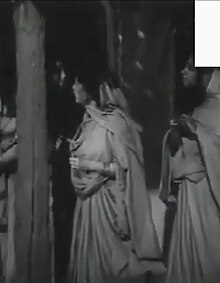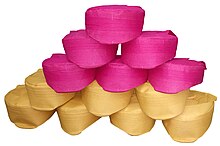Mithila culture or Maithil culture refers to the culture which originated in the Mithila region of the Indian subcontinent. Mithila comprises Tirhut, Darbhanga, Kosi, Purnia, Munger, Bhagalpur and Santhal Pargana divisions of India and adjoining provinces of Province No. 1, Bagmati Pradesh, and Madhesh Province of Nepal.
Men and women in Mithila are very religious and dress for the festivals as well. The costumes of Mithila stem from the rich traditional culture of Mithila. Maithil Kurta tied from left side with a (Dori)string and Dhoti with a Mithila Painting bordered Maroon coloured Gamchha which is the Symbol of Passion, Love, Bravery and Courage are common clothing items for men. Men wear Gold Baali in their nose which symbolizes prosperity, happiness and wealth inspired by Lord Vishnu. Also wear Balla on their wrist and Mithila Paag on their Head. In ancient times there was no colour option in Mithila, so the Maithil women wore white or yellow Saree with red Border but now they have a lot of variety and colour options and wear Laal-Paara (the traditional red-boarded white or yellow Saree) on some special occasions, and also wear Shakha-Pola with lahthi in their hand which is Mandatory to wear after marriage in Mithila. In Mithila culture, this represents new beginnings, passion and prosperity. Red also represents the Hindu goddess Durga, a symbol of new beginnings and feminine power.
In Mithila's all Districts, Maithil women follow Maithil Saree Style.



In this Saree Style, Saree covers upper body of women where they do not wear Blouse and the pallu of the saree is rotated around the neck and brought forward. In Maithil Drape of Mithila they used to take it like Odhni so that entire body gets covered since Maithil women didn't wear blouse and still In Mithila during Chhaith, the women of Mithila wear pure cotton Dhoti without stitching where women don't wear blouse which reflects the pure, Traditional Culture of Mithila. Usually crafted from pure cotton for daily use and from pure silk for more glamorous occasions, traditional attire for the women of Mithila includes Jamdani, Banarisi and Bhagalpuri and many more.
Many festivals are celebrated throughout the year in Mithila. Chhaith, Durga Puja and Kali puja is celebrated as perhaps the most important of all the celebrations of Mithila.
Headgear
Main article: Paag
The Paag is a headdress native to the Mithila region worn by Maithil people. It is a symbol of honour and respect and a significant part of the Maithil culture.
Darbhanga MP Gopal Jee Thakur popularised the culture of honouring people with Mithila’s Paag on their head.
Dances
Jhijhiya, Dhuno-Naach and Domkach are the Cultural Dance of Mithila region of India and Nepal. Jhijhiya is mostly performed at time of Dusshera, in dedication to Durga Bhairavi, the goddess of victory. While performing jhijhiya, women put lanterns made of clay on their head and they balance it while they dance. Jhijhiya is performed in Darbhanga, Muzaffarpur, Madhubani and their Neighbour Districts on the other hand Dhuno-Naach is performed in Begusarai, Khagaria, Katihar, Naugachia during Durga Puja and Kalipuja with Shankha-Dhaak Sound. Domkach is also a folk dance of the Mithila region.
Paintings
Main article: Madhubani/Mithila PaintingMithila painting is practiced in the Mithila region of India and Nepal. It was traditionally created by the women of different communities of the Mithila region. It is named after Mithila in India which is where it originated. This painting as a form of wall art was practiced widely throughout the region; the more recent development of painting on paper and canvas originated among the villages around Madhubani, Begusarai, Darbhanga, Naugachia and it is these latter developments that may correctly be referred to as Madhubani art, Begusarai Art, Darbhanga Art, Naugachia Art.
Cuisine
Main article: Maithil cuisineSome traditional Maithil dishes are:
- Dahi-Chura
- Vegetable of Arikanchan
- Ghooghni
- Tarua of Tilkor
- Bada
- Badee
- Dalpithhi
- Maachh
- Mutton
- Irhar
- Pidakia
- Dal bhat
- Makhan Payas
- Anarasa
- Bagiya
- churlay
- Murlay
Main festivals
- Chhaith: Prayers during Chhath puja are dedicated to the solar deity, Surya, to show gratitude and thankfulness
- Saama-Chakeba: includes folk theater and song, celebrates the love between brothers and sisters and is based on a legend recounted in the Puranas.
- Oghaniya Chhaith (Chhotka Pabni): Very popular with the name of "Chhotka-Pabni" and Dopaharka Aragh in Mithila.Celebrated in Oghan Shukla-paksha Shasthi tithi.
- Baisakkha Chhaith (Chhotka Pabni): This is celebrated in month of Baishakh Shukla-paksha Shasthi tithi and It is also called Chhotka-Pabni(Dopaharka Aragh) in Mithila.
- Chaurchan: Along with Lord Ganesha, Lord Vishnu, Goddess Parvati and the moon god is worshipped. The story of Chorchan Puja is also heard on this day after that arghya is offered to the moon god (Chandra Deva).
- Jitiya: celebrated mainly in Indian states of Bihar, Jharkhand and Uttar Pradesh and Nepal; mothers fast (without water) for wellbeing of their children.
- Vivaha Panchami: Hindu festival celebrating the wedding of Rama and Sita. It is observed on the fifth day of the Shukla paksha or waxing phase of moon in the Agrahayana month (November – December) as per Maithili calendar and in the month of Margashirsha in the Hindu calendar.
- Sita Navami
- Ganga Dussehra: Ganga Dussehra, also known as Gangavataran, is a Hindu festival celebrated by Maithils in Mokshdhaam Simaria Dhaam (The Welcome Gate of Mithila). avatarana (descent) of the Ganges. It is believed by Hindus that the holy river Ganges descended from heaven to earth on this day.
- Kalpwas: Celebrated in Every Kartik Month in Simaria Dhaam, Begushorai.
- Kojagiri (Lachhmi Puja): harvest festival marking the end of monsoon season
- Paata Puja (Durga Maay Aagmon)
- Khutti Puja (Ritual of Durga Puja)
- Mohalaya
- Durga Puja: a ten-day festival, of which the last five are of the most significance. is an important festival in the Shaktism tradition of Hinduism. It marks the victory of goddess Durga in her battle against the shape-shifting asura, Mahishasura. Thus, the festival epitomizes the victory of good over evil, though it is also in part a harvest festival celebrating the goddess as the motherly power behind all of life and creation.
- Kali Puja: dedicated to the Hindu goddess Kali, celebrated on the new moon day Dipannita Amavasya of the Hindu month Kartik
- Saraswati Puja: marks the preparation for the arrival of spring. The festival is celebrated by people of Dharmic religions in the South Asian countries in different ways depending on the region. Vasant Panchami also marks the start of preparation for Holika and Holi, which take place forty days later.
- Rama Navami: celebrates the descent of Vishnu as the Rama avatar, through his birth to King Dasharatha and Queen Kausalya in Ayodhya, Kosala.
- Basanti Puja (Chaiti Durga Puja)
- Til Sakraait
- Aakhar Bochhor
- Pahun Shashthi
- Naag Panchami
- Barsaait
- Vishwakarma Puja
- Holi
- Ghadi Paabain
- Madhushravani
Worship places
See also
References and footnotes
Notes
- In the Shakta tradition of Hinduism, many of the stories about obstacles and battles have been considered as metaphors for the divine and demonic within each human being, with liberation being the state of self-understanding whereby a virtuous nature & society emerging victorious over the vicious.
- Jha, Pankaj Kumar (2010). Sushasan Ke Aaine Mein Naya Bihar. Bihar (India): Prabhat Prakashan. ISBN 9789380186283.
- Maithil women wore Red Boarded Yellow or White Saree during Jhijhiya Naach. Retrieved 27 March 2017.
- "Mithila as well as Bengal wearing शाखा पोला" www.jhajistore.com". Retrieved 12 August 2019.
- "Mithila: Donning Mithila's 'paag' in Houses | Patna News - Times of India". The Times of India. 31 July 2016.
- "Darbhanga MP meets PM Modi; demands renaming of airport". Hindustan Times. 12 August 2021. Retrieved 1 March 2023.
- Nishi Sinha (1999). Tourism Perspective in Bihar. APH. p. 39. ISBN 9788170249757.
- Punam Kumari (1999). Social and cultural life of the Nepalese. Mohit Publications. ISBN 978-81-7445-092-0.
- Nishi Sinha (1999). Tourism Perspective in Bihar. APH. p. 40. ISBN 9788170249757.
- "Domkach". Archived from the original on 21 February 2019.
- Madhubani Painting. Abhinav Publications. 2003. p. 96. ISBN 9788170171560. Archived from the original on 28 October 2017. Retrieved 20 February 2017.
- Carolyn Brown Heinz, 2006, "Documenting the Image in Mithila Art," Visual Anthropology Review, Vol. 22, Issue 2, pp. 5-33
- "Details". Archived from the original on 24 December 2019. Retrieved 15 September 2019.
- "Maithil Cuisine".
- "सर्दी में बनने वाले खास स्नैक्स में से एक है यह गुड़ की बगिया".
- "Chauth Chand 2022: आज मनाई जाएगी चौठ चन्द्र पूजा, चांद की इस तरह होती है पूजा". Prabhat Khabar (in Hindi). 30 August 2022. Retrieved 30 August 2022.
- "Chaurchan Puja 2022 Wishes & Chauth Chandra Puja HD Images: Celebrate This Bihar Festival of the Moon on Ganesh Chaturthi Sharing Chaurchan Photos, Messages & Wallpapers | 🙏🏻 LatestLY". LatestLY. 30 August 2022. Retrieved 30 August 2022.
- "Jivitputrika Vrat 2020: जीवित्पुत्रिका व्रती महिलाएं आज खोलेंगी व्रत, जानें पारण करने के लिए हर एक शुभ समय और विधि". 11 September 2020.
- "Jivitputrika Vrat 2016 (Jitiya 2016) Date & Hindu Panchang - Indian Astrology". 18 July 2016. Archived from the original on 1 November 2016. Retrieved 4 September 2016.
- Agnihotri, Sanjana (14 June 2016). "All you need to know about Ganga Dussehra". India Today. Retrieved 4 July 2016.
- Doniger 1999, p. 306. sfn error: no target: CITEREFDoniger1999 (help)
- Lochtefeld 2002, p. 208. sfn error: no target: CITEREFLochtefeld2002 (help)
- Parmita Borah (2 October 2011). "Durga Puja - a Celebration of Female Supremacy". EF News International. Archived from the original on 25 April 2012. Retrieved 26 October 2011.
- McDermott 2001, pp. 172–174. sfn error: no target: CITEREFMcDermott2001 (help)
- Foulston & Abbott 2009, pp. 162–169. sfn error: no target: CITEREFFoulstonAbbott2009 (help)
- Rodrigues 2003, pp. 7–8. sfn error: no target: CITEREFRodrigues2003 (help)
- Daniélou 1991, p. 288. sfn error: no target: CITEREFDaniélou1991 (help)
- McDaniel 2004, pp. 215–219. sfn error: no target: CITEREFMcDaniel2004 (help)
- McDaniel 2004, pp. 20–21, 217–219. sfn error: no target: CITEREFMcDaniel2004 (help)
- Kinsley 1988, pp. 111–112. sfn error: no target: CITEREFKinsley1988 (help)
- Donner 2016, p. 25. sfn error: no target: CITEREFDonner2016 (help)
- Christian Roy (2005). Traditional Festivals: A Multicultural Encyclopedia. ABC-CLIO. pp. 192–193. ISBN 978-1-57607-089-5.
- Hindus around the world celebrate Ram Navami today, DNA, 8 April 2014